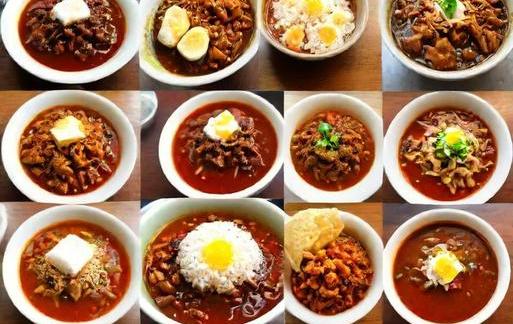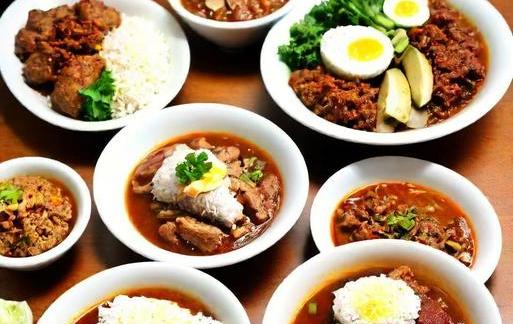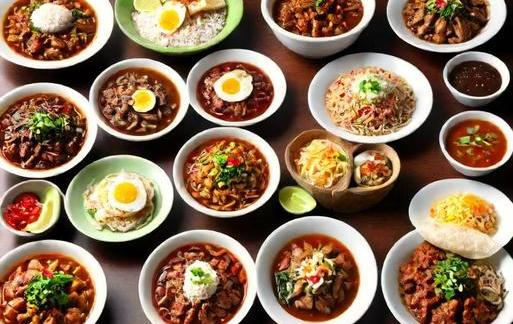- You are here:
- Home »
- Food
- » [REVEALED] Filipino Foods That Start With A
[REVEALED] Filipino Foods That Start With A
Note: This page contains affiliate links.
As an Amazon Associate, I earn from qualifying purchases when you click on the link, but you are not charged extra.
Filipino cuisine is a rich tapestry of flavors, blending indigenous ingredients with influences from Spanish, Chinese, and American cuisines. From savory to sweet, Filipino dishes showcase a diverse range of tastes that cater to various preferences. In this comprehensive article, we will explore the gastronomic delights of Filipino foods that start with the letter ‘A’. Each dish is a testament to the culinary artistry and cultural diversity that defines Filipino cooking.
Contents
List Of Filipino Foods That Start With A

1. Adobo
Adobo is arguably one of the most iconic Filipino dishes, known for its bold and savory flavors. This dish involves marinating meat, commonly chicken or pork, in a mixture of soy sauce, vinegar, garlic, and various spices. The marinated meat is then simmered until tender, creating a delectable blend of tangy and savory notes. Adobo reflects the Filipino penchant for combining simple ingredients to create a dish that is both flavorful and comforting.
2. Arroz Caldo
Arroz Caldo, often referred to as Filipino chicken congee, is a soothing and hearty rice porridge. Made with glutinous rice, chicken, ginger, and garlic, this dish is the Filipino version of comfort food. It is often garnished with green onions, crispy garlic, and a drizzle of calamansi juice for added zing. Arroz Caldo is a popular choice during rainy days or when seeking a warm and filling meal.
3. Ampalaya Salad
Ampalaya, also known as bitter gourd or bitter melon, takes center stage in this refreshing and nutritious salad. Thinly sliced ampalaya is combined with tomatoes, onions, and salted egg, creating a vibrant medley of flavors and textures. The bitterness of ampalaya is balanced by the saltiness of the egg and the acidity of tomatoes, resulting in a delightful salad that is both tasty and health-conscious.
4. Adidas
No, we’re not talking about the famous sportswear brand. In Filipino cuisine, Adidas refers to grilled chicken feet skewers. Marinated in a flavorful mixture of soy sauce, vinegar, and spices, the chicken feet are then skewered and grilled to perfection. This street food delicacy showcases the Filipinos’ ingenuity in transforming seemingly unconventional ingredients into a tasty and enjoyable snack.
5. Achara
Achara is a Filipino version of pickled green papaya relish. Grated green papaya is combined with carrots, bell peppers, onions, and garlic, then pickled in a sweet and tangy brine. This condiment adds a burst of flavor and crunch to various Filipino dishes, particularly those that are rich and savory. Achara is a versatile accompaniment that complements everything from grilled meats to fried fish.
6. Atsara
Atsara is another variation of pickled relish in Filipino cuisine. Unlike Achara, Atsara features a mix of shredded green papaya, julienned carrots, and red bell peppers. The vegetables are pickled in a blend of vinegar, sugar, and spices, resulting in a sweet and tangy condiment. Atsara is commonly served as a side dish or used as a topping for grilled or fried foods, adding a zesty kick to each bite.
7. Adlai
Adlai is a type of ancient grain that has gained popularity in the Philippines as a healthier alternative to rice. Similar in appearance to rice, adlai has a nutty flavor and a chewy texture. It is often used in various dishes, from salads to main courses. Adlai is celebrated for its nutritional benefits, being rich in fiber and essential nutrients. Its versatility makes it a welcome addition to Filipino meals, catering to those seeking a nutritious and satisfying option.
8. Alimango
Alimango, or mud crab, is a prized ingredient in Filipino seafood cuisine. Whether steamed, grilled, or cooked in coconut milk, alimango offers a sweet and succulent meat that delights seafood enthusiasts. Crab dishes, such as the popular Ginataang Alimango (crab cooked in coconut milk), showcase the Filipinos’ adeptness at transforming fresh seafood into mouthwatering creations.
9. Adlai Bibingka
Bibingka, a traditional Filipino rice cake, gets a modern twist with the incorporation of adlai. Adlai bibingka is made by combining adlai flour with coconut milk, sugar, and baking powder. The mixture is then poured into molds and baked until golden brown. The result is a delicious fusion of traditional flavors and a healthier alternative, offering a delightful treat for those with a sweet tooth.
10. Ampaw
Ampaw, or puffed rice, is a popular Filipino snack known for its light and crispy texture. Made by frying glutinous rice until it puffs up, ampaw is often shaped into flat discs or balls. It is a versatile snack that can be enjoyed on its own or paired with other Filipino sweets. The simplicity of ampaw belies its addictive nature, making it a favorite among both children and adults.
In this culinary journey through Filipino foods that start with the letter "A", we've explored a diverse array of dishes that exemplify the richness and creativity of Filipino cuisine. From the savory delights of Adobo and Adidas to the comforting warmth of Arroz Caldo, each dish tells a story of tradition, innovation, and a deep connection to local flavors. Filipino cuisine continues to captivate the world with its unique blend of ingredients, techniques, and cultural influences. Whether you're savoring the umami of Adobo or indulging in the sweetness of Adlai Bibingka, Filipino foods that start with 'A' offer a tantalizing glimpse into the vibrant and dynamic culinary landscape of the Philippines. As we celebrate these delectable creations, it's clear that Filipino cuisine is not just about food; it's a celebration of heritage, community, and the joy of sharing flavorful moments with loved ones.
Significance

The rich and diverse culinary landscape of the Philippines is a reflection of its vibrant culture and history. With a plethora of flavors, textures, and unique dishes, Filipino cuisine has gained recognition worldwide.
Before delving into specific dishes, it’s essential to understand the significance of Filipino cuisine. The culinary heritage of the Philippines is a fusion of indigenous, Malay, Spanish, Chinese, and American influences. This amalgamation of flavors has given rise to a wide array of dishes that cater to diverse palates.
Filipino food is more than just sustenance; it is a cultural expression, a representation of the Filipino people’s identity. It serves as a connection to history, with each dish carrying a story and tradition passed down through generations. Exploring Filipino foods that start with ‘A’ allows us to unravel a small but flavorful part of this culinary tapestry.
Category-Related

Adobo
Adobo, a quintessential Filipino dish, is a savory and tangy stew that can feature various meats such as chicken, pork, or beef. The primary ingredients include soy sauce, vinegar, garlic, bay leaves, and pepper. Each region in the Philippines has its unique take on adobo, showcasing the diversity of Filipino cuisine. The slow-cooking process allows the flavors to meld, creating a symphony of taste that has made adobo a beloved dish not only in the Philippines but worldwide.
Arroz Caldo
Arroz Caldo is a comforting rice porridge that has become a staple in Filipino households, especially during rainy or chilly weather. It typically consists of glutinous rice, chicken, ginger, garlic, and safflower. The dish is garnished with hard-boiled eggs, green onions, and crispy fried garlic, adding layers of texture and flavor. Arroz Caldo is more than just a dish; it embodies warmth and nostalgia, making it a favorite comfort food across the archipelago.
Atchara
Atchara, a pickled side dish, is a delightful accompaniment to many Filipino meals. It is made from grated unripe papaya, carrots, bell peppers, ginger, onions, and garlic, all marinated in vinegar and sugar. The result is a sweet and tangy relish that adds a burst of flavor to dishes. Atchara is not only a palate cleanser but also a versatile condiment that complements the richness of many Filipino dishes.
Adlai
While not as widely known as other Filipino staples, adlai is a traditional grain that has gained popularity for its nutritional value. Similar to rice, adlai is a gluten-free alternative that is rich in fiber and essential nutrients. It has become a popular choice for those looking to incorporate healthier options into their diet. Adlai is often used as a substitute for rice in various Filipino dishes, offering a unique twist to familiar recipes.
Common Themes
Filipino foods that start with ‘A’ share common themes that reflect the essence of Filipino cuisine.
Fusion Of Flavors
One prevalent theme is the fusion of flavors. Filipino dishes often balance sweet, salty, sour, and umami tastes, creating a harmonious blend that tantalizes the taste buds. The combination of soy sauce and vinegar in adobo, for example, exemplifies this flavor synergy, showcasing the Filipino knack for achieving a perfect balance in every bite.
Use Of Indigenous Ingredients
Filipino cuisine celebrates the use of indigenous ingredients that are abundant in the archipelago. From the locally sourced meats in adobo to the native papaya and ginger in atchara, these ingredients not only contribute to the distinct flavors but also connect the cuisine to the land and its people.
Culinary Adaptability
Another theme is the culinary adaptability seen in Filipino dishes. The ability to adapt recipes to local ingredients and preferences has resulted in diverse regional variations of the same dish. Adobo, for instance, may have different iterations depending on whether you’re in Luzon, Visayas, or Mindanao. This adaptability is a testament to the dynamic nature of Filipino cooking.
Interesting Facts
Culinary Influences
Filipino cuisine is a product of historical influences, with each invasion and colonization leaving its mark on the food. The ‘A’ dishes we explored showcase this amalgamation – adobo has Spanish roots, arroz caldo exhibits Chinese influences, and atchara reflects the Filipino adaptation of pickling techniques introduced by the Chinese.
Global Recognition Of Adobo
Adobo, in particular, has gained international acclaim. In 2018, the term "adobo" was officially recognized by the Oxford English Dictionary, solidifying its place not just in Filipino kitchens but on the global culinary stage. This recognition highlights the widespread appreciation for the complex and delicious flavors of adobo.
Arroz Caldo As Historical Comfort
During the Japanese occupation of the Philippines in World War II, arroz caldo played a significant role as a comfort food. The simplicity of its ingredients made it accessible during difficult times, providing sustenance and solace to many Filipinos. Today, arroz caldo remains a symbol of resilience and the enduring spirit of the Filipino people.
Conclusion
Filipino foods that start with ‘A’ offer a tantalizing glimpse into the rich tapestry of Filipino cuisine. From the savory delights of adobo to the comforting warmth of arroz caldo, each dish tells a story of tradition, adaptation, and the vibrant flavors that define Filipino cooking. As we explore the significance, common themes, and interesting facts surrounding these dishes, we gain a deeper appreciation for the cultural and historical roots that make Filipino cuisine a true culinary gem. So, the next time you savor the flavors of adobo or enjoy a bowl of arroz caldo, remember that you are not just indulging in a meal – you are experiencing a piece of Filipino history and heritage.


